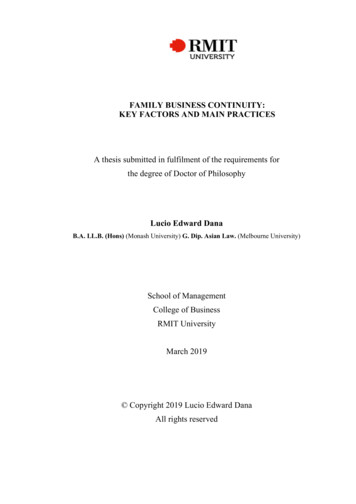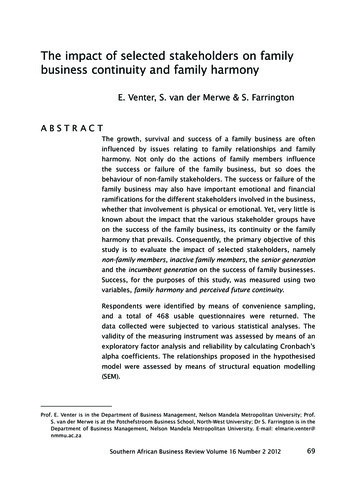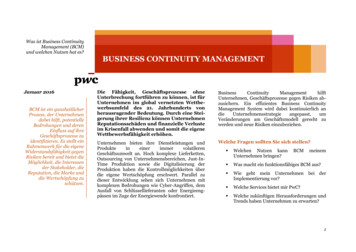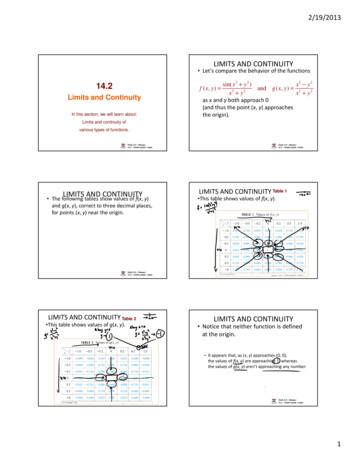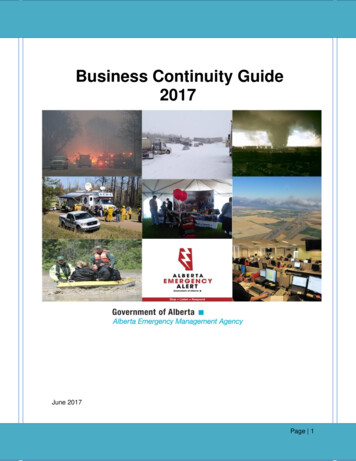
Transcription
Continuity of Care With Family MedicinePhysicians: Why It MattersSpending and Health Workforce
Our VisionBetter data. Better decisions.Healthier Canadians.Our MandateTo lead the development andmaintenance of comprehensiveand integrated health informationthat enables sound policy andeffective health system managementthat improve health and health care.Our ValuesRespect, Integrity, Collaboration,Excellence, Innovation
Table of ContentsAcknowledgements .4Executive Summary .5Introduction .6Methodology .6Data Sources .6Definitions and Calculations .7Continuity of Care .7Ambulatory Care Sensitive Conditions .8Family Practice Sensitive Conditions .8Defining Urban and Rural Areas .8Statistical Analysis .9Limitations .9Data Sources .9Measure of Continuity of Care .10Results .11Patients’ Interactions With Their Family Medicine Physicians .11Continuity of Care With Family Medicine Physicians .12Use of Hospital Services for ACSCs and FPSCs .15Impact of Relational Continuity of Care .17Impact of Using Hospital Services for Conditions That Can Be Managed byFamily Medicine Physicians .20Conclusions .21Considerations for the Future .22Appendix A: Data Sources .23Appendix B: Defining Ambulatory Care Sensitive Conditions .24Appendix C: Defining Family Practice Sensitive Conditions .26References .32
Continuity of Care With Family Medicine Physicians: Why It MattersAcknowledgementsThe Canadian Institute for Health Information (CIHI) wishes to acknowledge and thank thefollowing individuals for their contribution to Continuity of Care With Family Medicine Physicians:Why It Matters: David Onyschuk, Director, Customer Relationship Management and Data Access, Alberta Health Mengzhe Wang, Manager, Health Systems Analysis, Methods and Analysis Unit, Alberta Health Jessica Walker, Senior Researcher and Statistical Analyst, Saskatchewan Ministry of Health Scott Oddie, Director, Measurement and Knowledge Integration, Alberta Health Services Dr. Nick Myers, Medical Director, Primary Health Care, Alberta Health Services Dr. Susan P. Phillips, Professor, Family Medicine and Public Health Sciences,Queen’s University Dr. Stafford Dean, PhD, Senior Program Officer, Analytics (DIMR), Alberta Health Services Jody Pow, Data Manager and Primary Healthcare Measurement Lead, Health QualityCouncil of AlbertaPlease note that the analyses and conclusions in this report do not necessarily reflect those ofthe individuals or organizations mentioned above.4
Continuity of Care With Family Medicine Physicians: Why It MattersExecutive SummaryInteractions with a family medicine physician and other front-line health care providers can bethe first point of contact that people have with the health care system, and can impact theirfuture use of hospital services. Past studies have shown that seeing the same family medicinephysician, and developing an ongoing relationship with that physician, is an essential element ofeffective primary health care. Studies indicate that relational continuity of care helps to establisha patient–provider relationship built on effective communication and mutual understanding.1, 2High levels of continuity of care have been linked to improved health outcomes,3, 4 reductions inemergency department use and reductions in hospitalizations.4–8This study uses patient-level physician billing data, hospital discharge data and emergencydepartment data to look at the relationship between continuity of care with a family medicinephysician (i.e., relational continuity) and the use of avoidable hospital services in Saskatchewanand Alberta. For this study, avoidable hospital services include services for conditions that areoften treated by hospitals (ambulatory care sensitive conditions [ACSCs]) and emergencydepartments (family practice sensitive conditions [FPSCs]) but may be more appropriatelymanaged by primary health care, where the opportunity exists to do so.In line with the literature, increased relational continuity of care was found to decrease the useof avoidable hospital services. Key findings from this study include the following: Patients were treated by the same family medicine physician 60.2% of the time in Albertaand 56.2% of the time in Saskatchewan. Continuity of care increased as patient age increased. Patients with higher continuity scores were less likely to Be hospitalized for an ACSC; and Visit an emergency department for an FPSC. Seeing a family medicine physician may be more cost-effective than using hospital resourcesto treat ACSCs and FPSCs.The report reinforces the importance of improved relational continuity of care. Looking foropportunities to increase continuity of care within primary health care could improve patient–provider relationships and the identification and management of chronic illnesses, and decreaseunnecessary hospital use.Furthermore, by decreasing the use of potentially avoidable hospital services, there is thepotential to be more cost-effective in the delivery of care.5
Continuity of Care With Family Medicine Physicians: Why It MattersIntroductionInteractions with a family medicine physician and other front-line health care providers can be thefirst point of contact that people have with the health care system. How people interact with thisfirst point of contact can impact their future use of hospital services. Past studies have shownthat seeing the same family medicine physician, and developing an ongoing relationship with thatphysician, is an essential element of effective primary health care. Studies indicate that continuityof care helps to establish a patient–provider relationship built on effective communication andmutual understanding.1, 2 High levels of continuity of care have been linked to improved healthoutcomes,3, 4 reductions in emergency department use and reductions in hospitalizations.4–8This study builds upon past studies by focusing on the relationship between continuity of careand the use of avoidable hospital services for ambulatory care sensitive conditions (ACSCs)and family practice sensitive conditions (FPSCs). It explores the relationship between increasedcontinuity of care and the number of hospitalizations for ACSCs and emergency departmentvisits for FPSCs.MethodologyThe study focuses on patient interactions with certain health services in Alberta and Saskatchewanover a 6-year period, from April 1, 2007, to March 31, 2013. The study focuses on these 6 yearsand these 2 provinces as this reflects what patient-level physician data is currently available toCIHI. It also allows us sufficient data to measure longitudinal relationships between patients andfamily medicine physicians. Pilot studies using 2007 to 2009 data and 2010 to 2012 data wereconducted previously. Results from the pilot studies based on 3 years of data yielded the sameresults as this study.Data Sources3 data sources were brought together to create a data set of patient interactions with their healthsystem. This data set included an indicator to identify hospitalizations for ACSCs andemergency department visits for FPSCs. Patient interactions with their family medicine physicians between April 1, 2007, andMarch 31, 2013, are held in the Patient-Level Physician Billing Data Repository. Hospitalizations for ACSCs between April 1, 2012, and March 31, 2013, were identified usingthe Discharge Abstract Database. Unscheduled emergency department visits for FPSCs between April 1, 2012, andMarch 31, 2013, were identified using the National Ambulatory Care Reporting System.Additionally, the Canadian MIS Database was used to create cost estimates for ACSCs andFPSCs for the 2012–2013 fiscal year. Data sources are described in more detail in Appendix A.6
Continuity of Care With Family Medicine Physicians: Why It MattersDefinitions and CalculationsContinuity of CareWithin the literature, continuity of care includes several key domains related to the interdisciplinaryteam approach to services provided across the care continuum: Information continuity: Information transfer across team members, etc. Management continuity: Coordination of care between different providers Relational continuity: Ongoing relationship between a patient and a health care provider6This study focuses on relational continuity of care as it examines the relationship betweenpatients and family medicine physicians. For the purpose of this study, relational continuity ismeasured using a commonly accepted measure—the Usual Provider Continuity (UPC) index.9, 10The UPC is calculated as the number of visits to the most frequently visited provider divided by thetotal number of visits to all providers. In this study, “provider” refers to a family medicine physician.UPC Number of visits to usual family medicine physicianTotal number of visits to all family medicine physiciansA UPC index score was calculated for all persons in the billing data with at least 2 visits to afamily medicine physician over the 6-year study period.Additionally, for the purposes of the predictive analyses, the UPC index score was categorizedinto 3 groups. Low UPC index scores ranged from 0.0 to 0.40, moderate UPC index scoresranged from 0.40 to 0.80 and high UPC index scores ranged from 0.80 to 1.00.Previous studies have used a variety of cut-off points to segment their data into low, moderateand high scores. In some instances, UPC index scores were categorized into 2 groupings, withscores higher than 0.75 or 0.5 being considered high.5, 7, 11 In other instances, scores werecategorized into 3 groupings, with scores below 0.5 representing low continuity of care andscores higher than 0.8 representing high continuity of care.6When analyzing our data, approximately one-quarter of patients were in the low ( 0.4) andhigh (0.8 ) categories. Additionally, the average UPC index score within our data was 0.56 inSaskatchewan and 0.60 in Alberta. Thus the selected cut-offs ensured an adequate sample inall 3 categories and allowed the average UPC index score to be in the middle of the moderatecategory. These cut-offs are also in line with those presented in the literature.7
Continuity of Care With Family Medicine Physicians: Why It MattersAmbulatory Care Sensitive ConditionsACSCs have been defined as conditions for which hospitalizations are largely preventable whenthey are managed by adequate primary health care on an outpatient basis. These conditionshave been well documented in the literature12, 13 and include Grand mal status and other epileptic convulsions; Chronic obstructive pulmonary diseases; Asthma; Diabetes; Heart failure; Pulmonary edema; Hypertension; and Angina.For a full list of the conditions and respective diagnosis codes using the International StatisticalClassification of Diseases and Related Health Problems (ICD), please see Appendix B.Family Practice Sensitive ConditionsFPSCs have been defined as conditions for which visits to an emergency department arelargely unnecessary, because they have less than 1% chance of resulting in an admission to ahospital and can be appropriately managed at a family medicine physician’s office. The FPSCmethodology was originally developed by the Health Quality Council of Alberta.14, 15 For thepurposes of this analysis, we followed the Alberta definition, excluding 2 codes pertaining todeath. For a full list of the 165 conditions that fall under this definition and the respectivediagnosis codes using the ICD, please see Appendix C.Defining Urban and Rural AreasFor Alberta data, urban and rural areas were derived using patients’ residential postal codes.Based on Statistics Canada’s methodology, postal codes within census metropolitan areas(CMAs) or census agglomerations (CAs) were coded as urban, while postal codes outside ofCMAs or CAs were coded as rural.For Saskatchewan data, patients’ residential postal codes were not available. The data setincludes a residence code for each patient, which is then mapped to various geographicboundaries, including an urban/rural indicator, by the data provider—the SaskatchewanMinistry of Health.8
Continuity of Care With Family Medicine Physicians: Why It MattersStatistical AnalysisDescriptive and predictive analyses (i.e., logistic regression) were conducted.Stepwise logistic regression was performed to assess the strength of the association betweencontinuity of care and ACSC hospitalizations/FPSC emergency visits. In line with the literature,demographic and health-related variables were included as control variables in the regressionmodels. All variables used in past studies that were available in our data set were tested in theregression model.To help ensure our study focused on measuring the impact of the patient–provider relationship,predictive analyses were limited to persons age 18 and older. When persons younger than 18visit a family medicine physician, they may do so with a parent or guardian who will make healthcare decisions on their behalf, thus making it more difficult to isolate a true patient–providerrelationship between the child and the provider.Additionally, for the purposes of the predictive analyses, the UPC index score was categorizedinto 3 groups. Low UPC index scores ranged from 0.0 to 0.40, moderate UPC index scoresranged from 0.40 to 0.80 and high UPC index scores ranged from 0.80 to 1.00.LimitationsData SourcesThis study is based on patient-level physician billing data provided by the physician. It does notanalyze continuity of care from the patient’s perspective, nor does it allow patients to identify theirprimary family medicine physician and/or to evaluate their patient–provider relationship. It alsodoes not provide us with information on how the family medicine physician’s practice is organized.Some data on patient visits to family medicine physicians where the physician was paid through analternative payment program (e.g., salary, sessional payments) can be identified in the billing data;however, the completeness of this data is unknown. To this end, this study focused on fee-for-servicepatient-level physician billing data to measure relational continuity of care. Fee-for-service dataaccounts for 63% of clinical payments to family medicine physicians in Saskatchewan and 86% ofclinical payments to all physicians i in Alberta.This study uses data from 2 provinces, and only for a 6-year period. Results may be different inother jurisdictions, where the range and mix of health care delivery models is different.i.Currently Alberta Health is unable to provide a breakdown to CIHI of total billings by payment mode (e.g., fee-for-service,alternative payments such as salary or sessional) by physician specialty type.339
Continuity of Care With Family Medicine Physicians: Why It MattersData on emergency department visits in Saskatchewan was available for only 5 hospitals, all ofwhich are located in urban areas within the 2 health regions of Saskatoon and Regina. These5 hospitals represent approximately 43% of all emergency department visits in Saskatchewan.Due to the lack of emergency department data outside of Saskatoon and Regina, the analysison FPSCs will focus only on Alberta.Measure of Continuity of CareRelational continuity of care is measured based on visits with a particular physician, not with aclinic or health team. This is in line with other studies, which indicate that continuity of care is notabout patients receiving care in the same location but from the same provider, thus building apatient–provider relationship where patient trust and open communication can be fostered.10, 16, 17Relational continuity of care is measured over multiple years in this study. It is possible that overthis time period, physicians will have moved in and out of the provinces studied, and/or thatresidents could have moved from one part of the province to another, requiring them to find a newfamily medicine physician. In both of these instances, the UPC index score would be affected.10
Continuity of Care With Family Medicine Physicians: Why It MattersResultsPatients’ Interactions With Their Family Medicine PhysiciansBetween 2007 and 2012, ii 4,128,905 residents visited a family medicine physician in Alberta.Over the same time period, 1,161,231 residents of Saskatchewan visited a family medicinephysician. As illustrated in Figure 1, over the course of these 6 years, patients who visited afamily medicine physician did so on average 21 times in Alberta and 23 times in Saskatchewan.In both jurisdictions, men visited their family medicine physicians less frequently than women(17 versus 24 in Alberta and 19 versus 27 in Saskatchewan) and the average number of visitsincreased with age. Those age 65 and older visited their family medicine physician on average39 times over the 6 years—about 3 times more frequently than those age 17 and younger(11 visits in Alberta and 14 visits in Saskatchewan).Figure 1: Average Number of Visits to Family Medicine Physicians Between2007 and 2012 by Age, Alberta and SaskatchewanSourcePatient-Level Physician Billing Data Repository, 2007 to 2012, Canadian Institute for Health Information.ii.Throughout this analysis, references are to fiscal years. For example, 2012 refers to the period April 1, 2012, to March 31, 2013.11
Continuity of Care With Family Medicine Physicians: Why It MattersContinuity of Care With Family Medicine PhysiciansA patient–provider UPC index score was calculated for each person who visited a familymedicine physician at least twice between 2007 and 2012—this represented 93.8% of patientsin Alberta and 95.5% of patients in Saskatchewan.Overall, patients were treated by the same family medicine physician 60.2% of the time inAlberta and 56.2% of the time in Saskatchewan.Figure 2 shows that the likelihood of being treated by the same family medicine physician wasnearly the same for men and women (i.e., the difference between the UPC index scores variedby 2 percentage points); however, likelihood did vary by age. While the UPC index scores weresimilar for patients in the 2 younger age groups (0 to 17 and 18 to 44), continuity started toincrease for those age 45 and older. The UPC index scores increased by approximately10 percentage points between patients age 18 to 44 and those age 45 to 64. Scores increasedby an additional 6 percentage points for the oldest cohort, with patients age 65 and olderseeing the same family medicine physician 71.9% of the time in Alberta and 66.4% of the timein Saskatchewan.Figure 2: Patient–Provider Continuity (UPC Index Scores) by Age, Alberta andSaskatchewan, 2007 to 2012NoteBased on all patients visiting a family medicine physician at least twice over the reference period.SourcePatient-Level Physician Billing Data Repository, 2007 to 2012, Canadian Institute for Health Information.12
Continuity of Care With Family Medicine Physicians: Why It MattersWhen analyzing relational continuity of care by patient location, there is very little difference inpatient–provider UPC index scores for those in urban or rural locations. In Alberta, the UPCindex was 60% in both urban and rural areas, iii and in Saskatchewan the index was 57% inurban areas and 55% in rural areas. ivAs demonstrated in Figure 3, within Alberta there was also little variation by health zone, withcontinuity measures ranging from a low of 58% and 59% in the Central and Calgary zones,respectively, to a high of 65% in the South zone.There was more variability in continuity of care between health regions in Saskatchewan,with levels being lower in the 3 most northern regions. v Continuity may be lower in the northfor a few reasons. It is harder to recruit physicians to these areas, so often locum physicians(i.e., physicians who are brought into an area for a short period of time) are used to ensurepatient access to a physician. Given that locum physicians are in the area for only a short time,there would naturally be more variability in the number of physicians a person would encounterfor primary health care. Additionally, those who feel they do not have a “regular” familyphysician may be more likely to use multiple clinics or walk-in services for primary health care,which would decrease continuity of care. Based on Statistics Canada’s 2013 CanadianCommunity Health Survey results, residents in the 3 most northern regions of Saskatchewanwere the least likely to indicate they had a regular medical doctor (58.7% in the northernregions, compared with 80.3% for Saskatchewan as a whole).18iii. In Alberta, urban/rural was defined by assigning postal codes to statistical area classifications based on StatisticsCanada’s definition.iv. In Saskatchewan, postal codes were not available; therefore, urban/rural was defined by the Saskatchewan Ministry of Healthusing residence codes.v. Lower continuity in the 3 northern regions appears to contradict findings that continuity is relatively similar in urban and rurallocations. Based on 2011 Census data, only 10.6% of residents living in rural areas live within these 3 northern regions.34, 35Because these areas represent only a small proportion of rural residents in Saskatchewan, results from these areas do nothave a significant impact on the overall results for rural Saskatchewan.13
Continuity of Care With Family Medicine Physicians: Why It MattersFigure 3: Patient–Provider Continuity (UPC Index Scores) by Health Region,Alberta and Saskatchewan, 2007 to 2012NotesBased on all patients visiting a family medicine physician at least twice over the reference period.Health regions as defined by Statistics Canada.SourcePatient-Level Physician Billing Data Repository, 2007 to 2012, Canadian Institute for Health Information.14
Continuity of Care With Family Medicine Physicians: Why It MattersUse of Hospital Services for ACSCs and FPSCsHospitalizations for Ambulatory Care Sensitive ConditionsOf those who visited a family medicine physician between 2007 and 2011, 14,767 patientsin Alberta and 6,389 patients in Saskatchewan were hospitalized with an ACSC betweenApril 1, 2012, and March 31, 2013. vi This represents 0.4% of the patient population in Albertaand 0.6% of the patient population in Saskatchewan.Figure 4 shows that, in both provinces, the likelihood of being hospitalized with an ACSCincreased with age—approximately 2% of patients age 65 and older were hospitalized for anACSC, compared with 0.2% of those younger than 18. Generally speaking, ACSCs are chronicconditions that are more prevalent among older populations; thus it is likely that hospitalizationfor these types of conditions would increase with age.19, 20 The likelihood of being hospitalizedwith an ACSC was also slightly higher in rural areas compared with urban areas (0.6% versus0.3% in Alberta and 0.7% versus 0.5% in Saskatchewan).Figure 4: Number and Percentage of Patients Hospitalized With an ACSC in Albertaand Saskatchewan in 2012, by Age, Gender and LocationNotesIn Alberta, urban/rural was defined by assigning postal codes to statistical area classifications based onStatistics Canada’s definition.In Saskatchewan, postal codes were not available; therefore, urban/rural was defined by the SaskatchewanMinistry of Health using residence codes.SourceDischarge Abstract Database, April 1, 2012, to March 31, 2013, Canadian Institute for Health Information.vi. This does not represent all hospitalizations for ACSCs and emergency department visits for FPSCs. It includes only thosehospitalizations/visits for people who had visited a family medicine physician over the past 5 years.15
Continuity of Care With Family Medicine Physicians: Why It MattersEmergency Department Visits for Family Practice Sensitive ConditionsOf those who visited a family medicine physician between 2007 and 2011, 289,278 patientsin Alberta had an unscheduled visit to an emergency department for an FPSC betweenApril 1, 2012, and March 31, 2013. This represents 7.4% of Alberta’s patient population. viiThe likelihood of having an unscheduled visit to an emergency department for an FPSCdecreased with age, in contrast to the hospitalizations for ACSCs, which increased with age.The difference in emergency department usage patterns was most pronounced among theyoungest patients. Overall, 17.1% of patients younger than 6 visited an emergency department,dropping to 8.8% for patients age 6 to 17. The percentage of patients visiting an emergencydepartment for an FPSC continued to decline at a more moderate rate, to 5.5% among thoseage 65 and older. The range of conditions included in FPSCs is varied (examples includesunburns, respiratory infections, corns, unspecified lumps in breast, rashes, immunizations,contraceptive management, dermatitis and middle ear infections). viii Higher use of hospitalservices for these types of conditions may reflect a perceived lack of access to a regular familymedicine physician, which is more prevalent among younger patients. According to findingsfrom the Canadian Community Health Survey, persons age 20 to 34 were the least likely toindicate they have a regular medical doctor (71.9% compared with 84.5% for the entireCanadian population).21Similar to hospitalization rates for ACSCs, the likelihood of having an unscheduled visit to anemergency department for an FPSC was higher in rural areas than urban areas (16.5% versus5.2%). It is important to consider the impact of health care delivery models in urban and ruralareas when interpreting these findings. For example, challenges with access to alternative caresettings may be greater in rural areas, or a broader range of services may be delivered in ruralemergency departments. In some instances, rural hospitals are staffed by one’s own familyphysician, which might lead one to view the hospital as an extension of office care.vii. NACRS emergency department data includes only 5 hospitals in the urban regions of Saskatoon and Regina and does notinclude information for the rest of Saskatchewan. Consequently analysis of FPSCs in Saskatchewan was not conducted.viii. For the full list of conditions defined as FPSCs, please refer to Appendix C.16
Continuity of Care With Family Medicine Physicians: Why It MattersFigure 5: Number and Percentage of Patients Having an Unscheduled Visit to anEmergency Department for an FPSC in Alberta in 2012, by Age, Genderand LocationNoteIn Alberta, urban/rural was defined by assigning postal codes to statistical area classifications based on StatisticsCanada’s definition.SourceNational Ambulatory Care Reporting System, April 1, 2012, to March 31, 2013, Canadian Institute for Health Information.Impact of Relational Continuity of CareOne of the main premises of relational continuity of care is that seeing the same providerhelps to build a relationship between the patient and provider, increasing patient trust andopen communication between parties.6, 16 This also leads to better illness identification andmanagement,7, 22 fewer hospitalizations for ACSCs22–24 and fewer unscheduled emergencydepartment visits for FPSCs.22, 23, 25Hospitalizations for Ambulatory Care Sensitive ConditionsThe likelihood of being hospitalized with an ACSC was found to be dependent on many factors,including patient demographics and health status. Using logistic regression, we found that theodds of being hospitalized for an ACSC were greatest for Males; Patients age 65 and older; Patients living in rural areas; and Patients who were being treated by their family medicine physician for an ACSC.17
and 56.2% of the time in Saskatchewan. Continuity of care increased as patient age increased. Patients with higher continuity scores were less likely to Be hospitalized for an ACSC; and Visit an emergency department for an FPSC. Seeing a family medicine physician may be more cost-effective than using hospital resources

